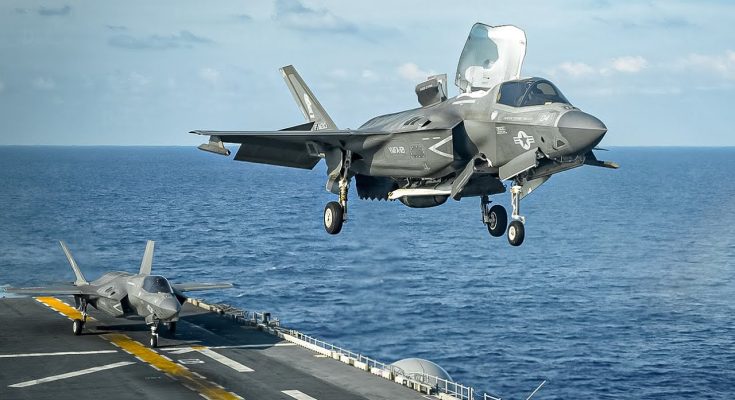The U.S. Marine Corps’ F-35B Lightning II is a remarkable example of modern military aviation, showcasing advanced capabilities that make it one of the most versatile fighter jets in the world. Designed for both sea and land operations, the F-35B is a key asset for the Marine Corps, enabling rapid deployment, enhanced combat effectiveness, and unmatched flexibility. Its ability to take off and land vertically, combined with cutting-edge technology and operational versatility, allows the F-35B to operate from a wide range of environments, including aircraft carriers, amphibious assault ships, and forward-operating bases.
Design and Capabilities
The F-35B is a variant of the fifth-generation F-35 Lightning II, developed by Lockheed Martin. Unlike traditional fighter jets, the F-35B is a short takeoff and vertical landing (STOVL) aircraft, meaning it can take off and land in tight spaces, including short runways and even the decks of ships. This unique capability is powered by a revolutionary lift fan system, which provides the necessary thrust for vertical takeoff and landing, and a swiveling jet nozzle that allows for the jet’s exhaust to be directed downward during takeoff and landing. This combination of advanced propulsion and design makes the F-35B a true multi-role aircraft, capable of performing a wide range of missions.
The F-35B is equipped with the latest avionics, radar, and sensor technology, making it one of the most advanced aircraft in the world. The aircraft features an integrated sensor suite, including a powerful radar system and infrared targeting capabilities, which allow it to detect, track, and engage targets with high precision, day or night, in all weather conditions. Its stealth capabilities ensure that it remains undetected by enemy radar, while its data-sharing systems enable it to operate seamlessly as part of a larger network of military assets.
Operational Flexibility: Sea and Land Missions
One of the key strengths of the F-35B is its ability to operate from both land and sea. For the U.S. Marine Corps, this means the aircraft can be deployed from amphibious assault ships, forward-operating bases, and even from austere, makeshift airstrips in combat zones. The ability to operate from these diverse platforms dramatically increases the Marine Corps’ global reach and responsiveness, especially in situations where traditional fixed-runway operations are not feasible.
The F-35B’s integration into amphibious operations is particularly significant. During a mission, the aircraft can rapidly take off from an amphibious assault ship, engage enemy targets, and return to land without needing large airstrips. This makes it an ideal asset for quick-response deployments in contested areas, as well as for operations in regions with limited infrastructure. This flexibility allows the Marine Corps to project force across the globe and execute a variety of missions, from close air support for ground troops to precision strikes against enemy targets.
Combat Readiness and Real-World Applications
The F-35B has already demonstrated its capabilities in real-world combat environments. Its ability to conduct both air-to-air and air-to-ground missions, coupled with its adaptability in different operational scenarios, makes it a critical component of the Marine Corps’ operational readiness. Whether engaged in counterterrorism operations, providing close air support for Marines on the ground, or participating in multinational exercises with allied forces, the F-35B is always ready to perform a wide range of missions.
The aircraft’s operational flexibility is also a significant asset during humanitarian missions and disaster relief operations, where it can land in challenging environments and quickly respond to urgent needs. In addition to its combat and operational roles, the F-35B has proven itself as a highly effective force multiplier, enhancing the Marine Corps’ overall capabilities and giving commanders on the ground a superior asset for decision-making and mission execution.
Conclusion
The U.S. Marine Corps’ F-35B Lightning II has demonstrated its incredible capabilities both at sea and on land, reinforcing its position as one of the most advanced and versatile aircraft in modern warfare. Its vertical takeoff and landing capabilities, combined with cutting-edge sensor technology and stealth features, allow it to operate effectively in a wide range of environments. Whether conducting combat missions, supporting humanitarian efforts, or participating in joint operations with allied forces, the F-35B is an invaluable asset that continues to strengthen the operational capabilities of the Marine Corps and U.S. military as a whole. With its adaptability, range, and state-of-the-art systems, the F-35B will remain a cornerstone of U.S. military air power for decades to come.



